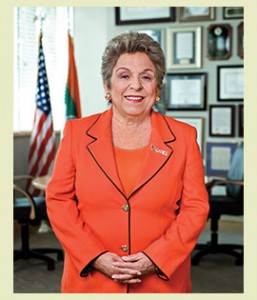Donna Shalala and The Boom Boom Theory

Connector.
Donna Shalala spoke at a breakfast meeting at the University of Denver (DU) the other day. She seems to be one of the most connected people on earth. She’s the former president of Hunter College, the University of Wisconsin, and the University of Miami. She also served for eight years as the Secretary of Health and Human Services during the Clinton administration. Perhaps most impressive (to me at least), over ten years at the University of Miami, she raised three billion dollars in voluntary contributions.
Our chancellor, Rebecca Chopp, interviewed Shalala before an audience of some 300 faculty, alumni, and students. The conversation soon turned to inclusive excellence (IE), which is a fundamental initiative at DU. We define IE as, “…the recognition that an … institution’s success is dependent on how well it values, engages and includes the rich diversity of students, staff, faculty, administrators, and alumni constituents. … The goal is to make IE a habit that is implemented and practiced consistently throughout …” the university.
Chancellor Chopp asked Shalala what advice she could offer to build an inclusively excellent university. Shalala’s answer reminded me that multi-channel communication is fundamental to multi-cultural success.
In a diverse community, Shalala noted, people have diverse communication styles. They may use the same word for different concepts. Or they may describe the same concept with different words. Further, they may well be tuned in to different channels.
Given the varying communication styles, Shalala argues that leaders of diverse communities need to deliver the same message multiple times, in multiple ways, through multiple channels to make sure it reaches all audiences. Shalala’s staff called this the Boom Boom theory of communication because one message (“Boom”) gets repeated across multiple channels.
It’s a good reminder that we need to repeat ourselves, perhaps more often than we think. I’ve written before that redundancy is not a sin; Shalala argues that we need to actively promote redundancy. Coupled with a concept like the sponsorship spine, the Boom Boom theory can produce effective communications in even the most diverse organization.
And what about those three billion dollars? Shalala says there’s no secret to fundraising. It requires a lot of patience and listening. Find out what your contributors are interested in and deliver it.
But patience and listening only take you so far. Shalala also reminded us of the value of good old-fashioned story telling. At fundraising events, she doesn’t talk about abstract concepts or programs or buildings. She simply tells stories. She admits that some of her stories “leave ‘em weepy” – they’re touching and effective. She wants her contributors to reach for their wallets. So first, she has to reach for their hearts. Combining the Boom Boom strategy with the leave-em-weepy tactics seems to be a killer combo.
Verbal, Vocal, Visual – Body Language and You

Let me explain quantum mechanics.
A woman says to a man, “Oh, you’re such a brute.” What does she mean? Well, it depends. The words have meaning in themselves but the way they’re delivered also counts for something.
Let’s say that she delivers the line with an aggressive posture, a scowl on her face, and a harsh tone in her voice. Most of us would conclude that the man should take her words literally; she’s angry and the man should back off.
On the other hand, let’s say she delivers the same line with a smile on her face, a flirtatious giggle in her voice, and a soft, inviting posture. She uses the same words but delivers them in a very different way. Most people would conclude that she doesn’t mean for her words to be taken literally. What she does mean may not be crystal clear but it’s probably not the literal words she speaks. (By the way, I adapted this example from an excellent article in New Scientist).
This is what Albert Mehrabian, the father of the so-called 7%-38%-55% rule, was studying. Mehrabian was trying to identify how face-to-face communication actually transpires, especially when the words are ambiguous. He identified three basic components: 1) the words themselves; 2) tone of voice; and 3) body language, including facial expressions. These are often summarized as the three V’s – verbal, vocal, visual.
In ambiguous situations, especially when discussing feelings, how do you sort out what the other person means? Mehrabian calculated that the words themselves account for 7% of the meaning (from the perspective of the receiver). Tone-of-voice accounts for 38% of the meaning, and body language accounts for 55%. To determine whether you’re really a brute or not, you should probably pay less attention to what the woman says and more attention to how she says it. (For more on the multiple meanings of simple words, click here).
Mehrabian’s findings may be accurate in the very specific case of conveying feelings in face-to-face communication. Unfortunately, far too many “experts” have over-extrapolated the data and applied it to all communications. When you give a speech, for instance, they may claim that 93% of what the audience receives comes from tone-of-voice and body language.
If that were really true, then why speak at all? If 93% of meaning comes from non-verbal channels, a good mime should be able to deliver a speech just as well as you can. Indeed, if 93% of communication is non-verbal, then why do we bother to learn foreign languages?
Fortunately or unfortunately, even Marcel Marceau (pictured) can’t effectively deliver an information-laden speech without words. Words are important – use them wisely and use them sparingly. Body language is also important. The best advice on body language is simple: you should appear comfortable and confident to your audience. If you don’t, your audience will wonder what you’re hiding. If you do appear comfortable and confident, your audience will attend to your words – for much more than 7% of the meaning.
When You Have a Heart Attack, Don’t Do It in a Crowd
Some years ago, Suellen, Elliot, and I flew from Los Angeles to Sydney, Australia — a long, somewhat dreary, overnight flight with several hundred people on a jumbo jet. The flight was smooth and uneventful with one bizarre exception. About six hours into the flight — as we were all trying to sleep — the plane’s oxygen masks suddenly deployed and fell into our laps. Nothing seemed wrong. There was no noise or bumping or vibration or swerving. Just oxygen masks in our laps. We woke up, looked around at the other passengers, concluded that nothing was wrong … and ignored the masks.
It turned out that we were right. The pilot announced that someone had “pushed the wrong button” in the cockpit and released the masks. He advised us to ignore the masks which we were already successfully doing. Later in the flight, I spoke with a flight attendant who told me she was shocked that none of the passengers had followed the “proper procedures” and donned the masks. I said that it seemed obvious that it wasn’t an emergency. She asked, “How did you know that?” I said, “By looking at the other passengers. Nobody was scared.”
I was reminded of this incident as I was re-reading (yet again) a chapter in Robert Cialdini’s book, Influence. Our little adventure on the airplane was a classic example of social proof. When we’re in an ambiguous situation and not sure what’s happening, one of the first things we do is to look at other people. If they’re panicking, then maybe we should too. If they’re calm, we can relax.
Cialdini points out that social proof affects us even when we’re aware of it. The example? Laugh tracks on TV. We all claim to dislike laugh tracks and also claim that they have no effect on us. But experimental research suggests otherwise. When people watch a TV show with a laugh track, they laugh longer and harder than other people watching the same show without the track. We realize that we’re being manipulated but we still succumb. According to Cialdini, the effect is more pronounced with bad jokes than with good ones. If so, Seth McFarlane clearly needed a laugh track at this year’s Academy Awards.
Cialdini refers to one of the problems of social proof as pluralistic ignorance. I looked around at other people on the airplane and they seemed calm and unfazed. At the same time, they were looking at me and I seemed … well, calm and unfazed. As I looked at them, I thought, “No need to get excited”. As they looked at me, they thought the same. None of us knew what was really going on but we were influencing each other to ignore a potentially life-threatening emergency.
Cialdini argues that pluralistic ignorance makes “safety in numbers” meaningless. (See also my post on the risky shift). Cialdini cites research on staged emergencies — a person apparently has an epileptic seizure. The person is helped “…85 percent of the time when there was a single bystander present but only 31 percent of the time with five bystanders present.” A single bystander seems to assume “if in doubt, help out”. Multiple bystanders look at each other and conclude that there’s no emergency.
So, what to do? If you have to have a heart attack, do it when only one other person is around.
Computers Are Useless. They Only Give You Answers.
 I’ve worked with some highly creative people during my career. I’ve also worked with very insightful thinkers, both in business and in academia. Oftentimes, the two skills overlap: creative people are also insightful thinkers and vice-versa. I’ve often wondered if creativity leads to insight or if insight leads to creativity. Lately, I’ve been thinking that there’s a third factor that produces both — the ability to ask useful questions.
I’ve worked with some highly creative people during my career. I’ve also worked with very insightful thinkers, both in business and in academia. Oftentimes, the two skills overlap: creative people are also insightful thinkers and vice-versa. I’ve often wondered if creativity leads to insight or if insight leads to creativity. Lately, I’ve been thinking that there’s a third factor that produces both — the ability to ask useful questions.
Indeed, the title of today’s post is a quote from Pablo Picasso, who seemed both creative and insightful. His point — computers don’t help you ask questions … and questions are much more valuable than answers.
So, how do you ask good questions? Here are some tips from my experience augmented with suggestions by Shane Snow, Gary Lockwood, Penelope Trunk, and Peter Wood.
It’s not about you — too often, we ask long-winded questions designed to show our own knowledge and erudition. The point of asking a question is to gather information and insight. Be brief and don’t lead the witness.
You can contribute to a better answer — even if you ask a great question, you may not get a great answer. The response may wander both in time and logic, looping forward and backward. You can help the respondent by asking brief, clarifying questions. Don’t worry too much about interrupting; your respondent will likely appreciate your help.
Remember your who, what, where, when, how … and sometimes why — these words introduce open-ended questions that often result in more information and deeper insights. Be careful with why. Your respondent may become defensive.
Don’t go too narrow too soon — decision theory has a concept called premature commitment. We see a potential solution and start to pursue it while ignoring equally valid alternatives. It can happen in your questions as well. Start with broad questions to uncover all the alternatives. Then decide which one(s) to pursue.
Dumb questions are often the best — asking an (open-ended) question whose answer may seem obvious often uncovers unexpected insights. Even if you’re well versed in a subject, don’t assume you know the answer from the respondent’s perspective. He or she may have insights you know nothing about.
Be aware of your ambiguities — even simple, seemingly straightforward questions can be ambiguous. Your respondent may answer one question when you intended another. Here’s a simple example: what’s the tallest mountain in the world? There are two “correct” answers: Mt. Everest (if you measure from sea level) or Chimborazo (if you measure from the center of the earth). Which question is your respondent answering?
Think of parallel questions — I’m reading a Kinsey Millhone detective novel (U is for Undertow). One of the important questions Kinsey asks herself is, “why were the teenage boys burying a dog?” It gets her nowhere. But a slight tweak to the question — “Why were the boys burying a dog there?” — provides the insight that solves the mystery. (Reading detective novels is a good way to learn questioning techniques).
Clarify your terms — my sister is an entomologist. She knows that there’s a difference between a bug and an insect. I use the terms more or less interchangeably. If I ask her a question about bugs, she’ll answer it in the technical sense even though I mean it in the colloquial sense. We’re using the same word with two different meanings. It’s a good idea to ask, “When you talk about bugs, what do you mean?”
Think about how you answer questions — when you respond to questions, observe which ones are annoying and which ones lead to interesting insights. Stockpile the interesting ones for your own use.
Silence is golden — when speaking on the radio, I might say “over” to indicate that I’m finished speaking and it’s your turn. In normal conversation, we use body language and tone-of-voice to make the same transfer. Breaking the expected etiquette can lead to interesting insights. You ask a question. The respondent answers and turns it back to you. You remain silent. There’s an awkward pause and, often, the respondent continues the answer … in a less rehearsed and less controlled manner. Interesting tidbits may just spill out.
Don’t be too clever — Peter Wood probably says it best, “A few people have a gift for witty, memorable questions. You probably aren’t one of them. It doesn’t matter. A concise, clear question is an important contribution in its own right”.
Social Media for Business Leaders
 As a marketing guy, I understand (sort of) the marketing aspects of social media. If you can start a conversation — and keep it interesting — you can engage your market in ways that are impossible with “interruption marketing”. You can exchange ideas, gather suggestions, support charities, and engage in positive social activities. Along the way, you can mention your products. You offer something of interest (or utility) and the products tag along for the ride.
As a marketing guy, I understand (sort of) the marketing aspects of social media. If you can start a conversation — and keep it interesting — you can engage your market in ways that are impossible with “interruption marketing”. You can exchange ideas, gather suggestions, support charities, and engage in positive social activities. Along the way, you can mention your products. You offer something of interest (or utility) and the products tag along for the ride.
But social media is not just about marketing. Executives should be able to use social media to enhance both internal and external communication. Yet, I haven’t found many examples in the literature. Fortunately, McKinsey just published an interesting case study based on GE’s experience. The authors, who are GE leaders themselves, point out that GE is not a “digital native” and its experiences may, therefore, be relevant to a wide range of organizations. They then outline six social media skills that all leaders need to learn. The first three are personal; the last three are strategic or organizational.
Producer — creating compelling content. Digital video tools are now widely available and easy to use. Even busy senior executives can weave them into their communications. As compared to traditional top-down communications, the emphasis shifts from high production quality to authenticity. The goal is to invite participation and collaboration. Speaking plainly and telling stories in an authentic voice invites participation much better than a highly produced video.
Distributor — leveraging dissemination dynamics. Instead of sending a message and expecting it be consumed, you now send a message and expect it to be mashed up. A successful social message will be picked up by people at all levels of the organization, commented on, “recontextualized”, and forwarded along. You want this to happen which means giving up a significant amount of control — not always an easy concept for executives. You also want to build up a followership within the organization long before you need it.
Recipient — managing communication overflow. We’re already drowning in information. Why take on social media? Because it’s more credible than top-down media. By learning to use filters effectively, you can also use social media to manage the flow of information to and from your desk. You should practice when and how to respond to postings and tweets. You don’t need to respond frequently but you do need to respond thoughtfully.
Advisor and orchestrator — driving strategic social media utilization. Fundamentally, executives need to promote the use of social media and guide it to maturity. Your company may be enthusiastic but inexperienced. Or you may have leaders who wish to avoid it altogether. A good leader can harness the enthusiasm of “digital natives” and even use them as “reverse mentors” to build capabilities within the organization.
Architect — creating an enabling organizational infrastructure. On the one hand, you want to encourage collaboration and free exchange. On the other hand, you need some rules. It helps if you have well-established values of integrity, collaboration, and transparency. If your company hasn’t established these values, it’s time to get started. Social media will arise in your organization whether you’re ready or not.
Analyst — staying ahead of the curve. As your organization masters social media, something new will emerge. Perhaps, it’s the Internet of Things. As I’ve noted before, this could help us reduce health care costs. It could also have huge implications for your organization — both good and bad. Better stay awake.
And what do you get if your company’s leaders master these skills? The authors say it best: “We are convinced that organizations that … master … organizational media literacy will have a brighter future. They will be more creative, innovative, and agile. They will attract and retain better talent, as well as tap deeper into the capabilities and ideas of their employees and stakeholders.”
